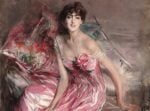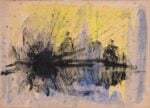L’immagine e il suo doppio
.jpg)
Mostra collettiva.
Comunicato stampa
L’immagine e il suo doppio
Curated by Domenico De Chirico
Eduardo Secci is pleased to present the exhibition “L’immagine e il suo doppio,” curated by Domenico de Chirico and featuring works by Sara Barker, Andrea Galvani, Sanam Khatibi, David Noonan, and Margo Wolowiec.
Doubles have always greatly interested philosophers; especially those focused on aesthetics studies. The search for something that is concealed behind an image has been dismantled even before the dawn of the phenomenology through which a new meaning of doubles was introduced, or, better, a new feeling. This feeling isn’t new, but rather a primordial feeling, probably the most ancient, pure, naïf and harmonic, or, in other words, one dating back to Ancient Greece. There are two ways of understanding doubles in its more dialectic sense: one is suggested by Jean-Pierre Vernant in his book “L’immagine e il suo doppio” and is drenched in sacredness in which the éidõlon (or ‘idol’, with the added value of ‘simulacrum’, ‘figure’) turns something absent or unreachable to present, in which the unveiling of the image is a constant gift; in another interpretation, a double is what mostly makes of an image the image, or what makes of theatre the theatre, as claimed by Antonin Artaud. Maybe, the most appropriate meaning of the double is found in the circle that turns and blends these two meanings, in which their dialectic becomes one, in which a double becomes the same manifestation of the image, which reaches its double when its capable of culminating the emptiness surrounding it in perceptive terms, and finds itself elevated at a higher degree, repeated. This circle seems to cross all the works in the exhibition, each one carrying an internal conflict between pairs of different nature, and which passionately seek to show to the eye the complex stratifications from which they have generated.
Strongly tied to the world of literature, of language, of medieval xylography, of illustrations and of a certain kind of painting, and by blurring out the boundaries between painting, drawing and sculpture, the artworks by Sara Barker position themselves in a specific state of perception of the image, conceived in its varied dimensionality. In her work, suspended between light and darkness, reflection and fluidity, there’s a particular attention to lines, patterns and colors. Characterized by fragmented images and elaborate stratifications, the work by Barker appears as codified and encrypted, without a definite narrative or a direct interpretation; the space, subjected to transformation and the inevitable process of regeneration, is present and absent at the same time, as it constantly reveals hidden perspectives and dimensions.
Defined by a solid and recognizable creative identity, by means of an interdisciplinary approach, which is also deeply open and receptive and often based on a scientific and rational methodology, the artistic practice of Andrea Galvani, in its attempt to push beyond a limit imposed by the need to delete in order to rebuild, offers an interpretation of the image by opening up glimmers of a landscape that is often concealed, in which subjects are transfigured and the limits of sensorial perception find their extension, between visible and invisible, fragility and strength. Galvani develops a conceptual epicenter that produces worlds of nature consisting of languages from which nature itself is generated.
The works by Sanam Khatibi, ranging from paintings, embroideries, tapestries and sculptures, concern “animality” and our primal impulses. Her practice mainly leads us to interrogate our relationship with structures of power, in particular the duality of triumph and failure. The recurring themes that often appear in her works question our relationship with excess, loss of control, bestiality, male-female dynamics, domination and submission. Khatibi is also interested in the thin line existing between fear and desire and their strong correlation. Her subjects live of their impulses in exotic and fascinating landscapes, and their ambiguity is underlined by the visceral interwining with themes of power, violence and sexuality.
David Noonan transforms images in black and white or sepia into majestic collages and silkscreen-printed tableaux on canvas or film. Noonan collects photographs, archival records, magazines and books related to utopian collectives of the ‘60s and ‘70s, theatrical and dance shows, and stratifies the result of such selection with other images of plants, animals and buildings. The stories merge together, while the sense of time and place is progressively blurred or decontextualized. Moreover, his research is an experiential reflection on theatre, on gestures, on time and on the tension between figuration and abstraction. Noonan recycles the past to create an alternative vision of it in the present.
Margo Wolowiec ranges from paradoxes to oxymorons to explore the worlds created by digitalization, social media and any other corner of cyberspace, while reviving an ancient form generated by a long manual dance. The artist, in fact, collects jpegs and tiffs under specific hashtags and geotags, and then transfers this composition by a process of sublimation of colors on polymer chords, and then spins the threads on a handloom to create a tapestry to which a gesture is sometimes added. The images acquire a connotation that goes beyond that of what is real or ideal, where personal becomes anonymous and what is private is now shared. The final outcome is the result of a wise harmony between speed, the neuroses of the images, and the slow meticulousness of the hand-weaving process. The constant battle between beauty and politics, information and knowledge, words and images, are just some of the tensions that can be perceived in a work made of clashes between painting, photography, textiles and sculpture.
Sara Barker (Manchester, UK, 1980) lives and works in Glasgow, UK. From 1999 to 2003 she studied painting at the BA (Hons) Fine Art of Glasgow School of Art, then, from 1998 to 1999, history of art at the University of Glasgow. Recent solo exhibitions include The Approach, London, UK (2017), the Jupiter Artland, Edinburgh, UK (2015), the Gallery of Modern Art, Glasgow, UK (2014), the BALTIC Centre for Contemporary Art, Gateshead, UK (2013). Her works have also been included in some group shows like Victoria Miro, London, UK (2018), Tate St. Ives, St. Ives, UK (2018), National Museum of Women in the Arts, Washington (2017), The Approach, London, UK (2017), Shane Campbell Gallery, Chicago, USA (2013), Tate Liverpool, UK (2012) and many others.
Andrea Galvani (Verona, Italy, 1973) lives and works between New York and Mexico City. Galvani earned a BFA in Sculpture from the Academy of Fine Arts in Bologna in 1999 and his MFA in Visual Art from Bilbao University in 2002. Adopting a cross-disciplinary approach that often draws upon scientific methodology, his conceptual research informs his use of photography, video, drawing, sculpture, sound, architectural installation, and performance. In 2017, his work was selected to represent the Deutsche Bank Collection at Frieze New York. A solo exhibition of Galvani took place at the Museum Mart, Rovereto (2016). Galvani's work has been exhibited internationally, including: the Poznan Biennal, (2012), Aperture Foundation, New York (2012), Calder Foundation New York (2012), Moscow Biennal (2011), Central Utah Art Center Ephraim, USA (2011), Mart, Rovereto (2010), Museo Macro (Roma), GAMeC Bergamo (2010), De Brakke Grond Amsterdam (2009), Oslo Plads, Copenaghen (2007) Whitney Museum New York (2006) and the Unicredit Pavillion (Bucarest). In 2011, he received the New York Exposure Prize and was nominated for the Deutsche Börse Photography Prize. His work is part of major public and private collections in Europe, the Americas, Asia, and Africa.
Sanam Khatibi (Tehran, Iran, 1979) lives and works in Brussels. Khatibi’s works deal with animality, and our primal impulses and the core of her practice interrogates our relationship to power structures, specifically the duality of triumph and failure. Recent solo exhibitions include the Artlead Salon, Brussels, Belgium (2018), The Cabin LA, Los Angeles CA, USA (2017). Her work was also included in several group exhibitions like Wschód Gallery, Warsaw, Poland (2018), Various Small Fires, Los Angeles, CA, USA (2017), Brussels, Belgium (2017), Christine Konig Gallery, Vienna, Austria (2016).
David Noonan (Ballarat, Australia, 1969) lives and works in London. The artist transforms black and white or sepia found imagery into striking collages and large-scale silk-screened tableaux on linen or films. Recent solo exhibitions include the Contemporary Art Museum, St. Louis, Missouri, USA (2011), the Australian Centre for Contemporary Art, Melbourne (2009) and the Palais de Tokyo, Paris (2007). In 2009, his work was included in the group show Altermodern, as part of the Tate Triennial, Tate Britain, London (2009). JRP/Ringier published two publications, a monograph (2012) and Scenes, an artist book in 2009.
Margo Wolowiec (Dearborn, Michigan, 1985) lives and works in Detroit, MI. She has a BFA from the School of the Art Institute of Chicago and an MFA from the California College of the Arts. She has been included in exhibitions at the Museum of Craft and Design (San Francisco), di Rosa Center (Napa), Jessica Silverman Gallery (San Francisco), Laura Bartlett Gallery (London) and Lisa Cooley Gallery (New York). She was a panelist at the Helen Frankenthaler institute in Manhattan for the Material Concerns and Current Practices series, and has lectured at Maryland Institute College of the Arts, San Francisco State University, and Penland School of Arts. She was a visiting critic at California College of the Arts and the Textile Art Center in Brooklyn, NY.



